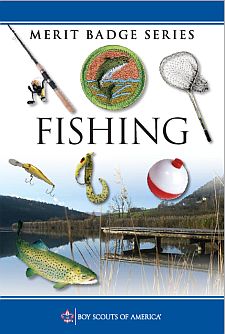- Explain to your counselor the injuries that could occur while fishing and the proper treatment, including cuts, scratches, puncture wounds, insect bites, hypothermia, dehydration, and heat reactions. Explain how to remove a hook that has lodged in your arm. Name and explain five safety practices you should always follow while fishing.
- Learn and explain the differences between two types of fishing outfits. Point out and identify the parts of several types of rods and reels. Explain how and when each would be used. Review with your counselor how to care for this equipment.
- Demonstrate the proper use of two different types of fishing equipment.
- Demonstrate how to tie the following knots: clinch, palomar, turle, blood loop (barrel knot), and surgeon's loop. Explain how each knot is used and when to use it.
- Name and identify five basic artificial lures and five natural baits and explain how to fish with them. Explain why bait fish are not to be released.
- Explain the importance of practicing Leave No Trace and how it positively affects fishing resources.
- Give the regulations affecting game fishing where you live. Explain why they were adopted and what you accomplish by following those regulations.
- Explain what good outdoor sportsmanlike behavior is and how it relates to fishermen. Tell how the Outdoor Code of the Boy Scouts of America relates to a fishing sports enthusiast, including the aspects of littering, trespassing, courteous behavior, and obeying fishing regulations.
- Catch two different kinds of fish and identify them. Release at least one of them unharmed. Clean and cook another fish.
BSA Advancement ID#:
52
Requirements last updated in:
2003
Pamphlet Publication Number:
00000
Pamphlet Stock (SKU) Number:
33231A
Pamphlet Revision Date:
2002
| Worksheets for use in working on these requirements: | Format | |
|---|---|---|
| Word Format | PDF Format | |
Page updated on: May 08, 2022









